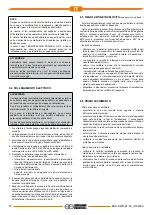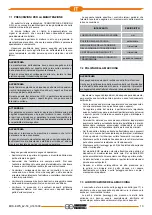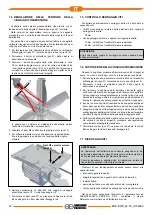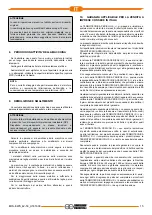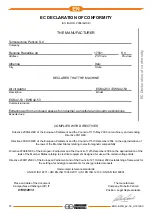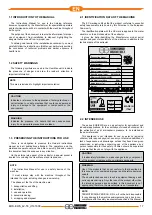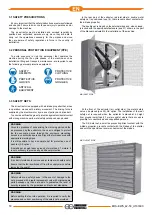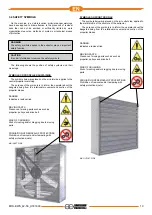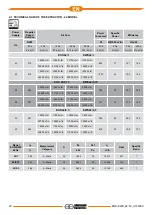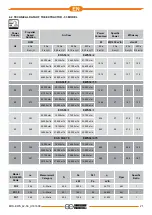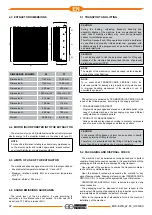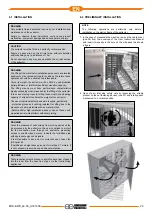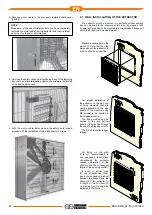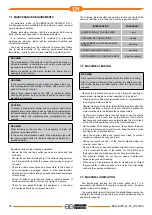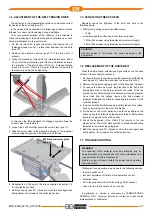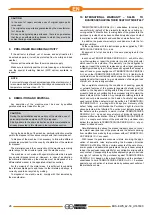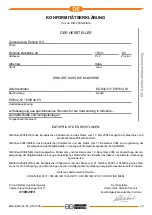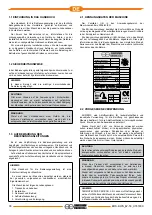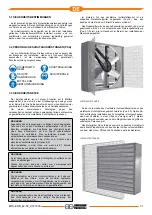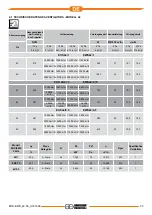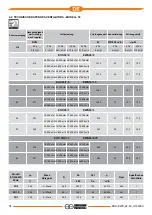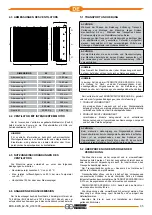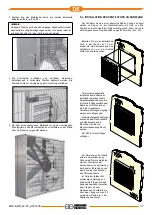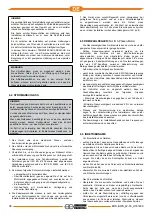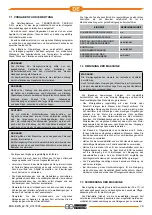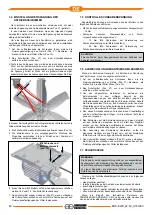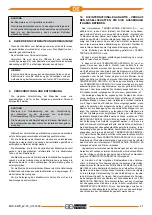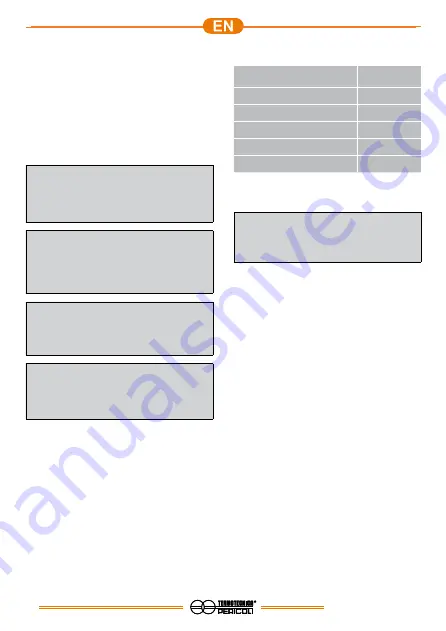
26
EOS-EWS_42-53_U161600
The following table specifies the periodic routine checks that the
user must perform to maintain the machine in good condition.
INTERVENTION
FREQUENCY
LUBRICATION OF THE MACHINE
never
CLEANING OF THE MACHINE
weekly
ADJUSTMENT OF THE DRIVE BELT
TENSION
quarterly
SCREW TIGHTNESS CHECK
quarterly
REPLACEMENT OF THE DRIVE BELT
when necessary
7.2 MACHINE CLEANING
WARNING
Never perform cleaning operations with the extractor running.
Also for external cleaning of the machine, the safety nets and
the shutter blades, prior disconnection from the mains supply
required.
Observe the following provisions, to be performed regularly to
ensure proper cleaning and proper operation of the product.
•
Clean the motor casing regularly with a brush or compressed air
(do not spray water or steam).
Regular cleaning of the motor is particularly important when the
extractor operates in dusty or dirty environments, because the
motor must be able to dissipate the heat generated.
On the motor models where they are present, use the plastic
caps placed on the cover and on the drawer of the motor to
discharge any condensate accumulated inside the motor itself;
at the end of the operation, restore the initial conditions.
•
On the bottom of the bearing structure of the extractor, there are
2 holes to discharge any water formed; keep the bottom clean
and free holes to avoid corrosion.
•
Keep the shutter blades and safety nets clean to prevent
excessive resistance during operation.
•
Keeps the levers (pos.30) of the shutter blades below the
shoulder cover clean.
On the EOS model, pay considerable attention to the cleaning
of the movement device of the blade. On the EWS model
thoroughly clean the blade opening centrifugal mechanism.
•
The propeller blades do not require special maintenance
because they are self cleaning.
•
When using a high pressure cleaner for cleaning, do not direct
the jet of water or steam directly on the motor or central pulley
or above the opening mechanisms.
7.3 MACHINE LUBRICATION
The ball bearing inserted into the driven pulley (pos. 17) is
permanently lubricated and requires no special care; the same
applies to the motor bearings.
The plastic parts (levers) that move the shutter flaps must not be
completely lubricated or greased to prevent accumulations of dust
and harmful deposits.
7.1 MAINTENANCE REQUIREMENTS
Air extractors made by TERMOTECNICA PERICOLI S.R.L.
are designed and manufactured for long life even under the most
severe service conditions.
Please remember however that this equipment HAS moving
parts, and as such they need to be checked regularly.
It is therefore recommended to implement a preventive
maintenance program, which will be entrusted to skilled and
competent personnel.
The daily inspection must be performed to prevent any failure
due to adverse effects of the working environment such as
temperature, humidity, dust, dirt and vibration, and other factors.
WARNING
The maintenance of the extractor must be performed only by
trained personnel in compliance with safety standards and
requirements set forth in this Manual.
Before connecting to the mains, isolate the power line by
opening the main switch.
WARNING
In the machine maintenance and inspection phases there is a
risk of entanglement and cutting of clothes, limbs, hair or other
parts of the body by the fan.
During these phases acquire the PPE, in particular safety
clothing and gloves, tie long hair back and do not wear rings,
bracelets or necklaces.
CAUTION
To ensure a high level of safety, use only original spare parts
available from your supplier. In case of using non-original parts,
full functionality and compliance with EC directives regarding
electrical safety and electromagnetic compatibility are not
ensured.
WARNING
When working on the machine, it is necessary to make all
personnel are aware of this.
In the event of maintenance work, affix a warning sign onto
the power supply switch to inhibit accidental operation by a
second operator.
Regularly carry out the following operations:
•
Ensure that the inlet and outlet openings are clean and free
of objects.
•
Ensure the extractor is always dry. If the extractor appears wet,
dry it immediately; identify the cause and remedy to prevent
corrosion.
•
Check the cable connections and connectors. In the event of
loose connections, damaged cables, or other abnormalities,
stop the extractor immediately and seek specialised assistance
or technicians.
•
Check for bolts or nuts that are loose or rusted because of
environmental conditions. In this case, tighten or replace.
•
Check for any deposits inside the equipment. In the case,
remove the deposits by compressed air jets.
Summary of Contents for EOS 42/0,5
Page 63: ......

